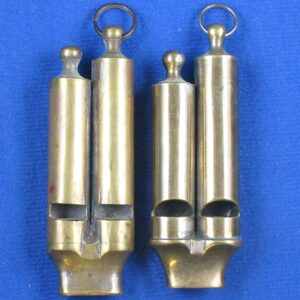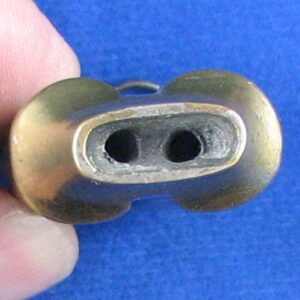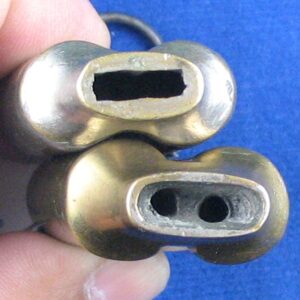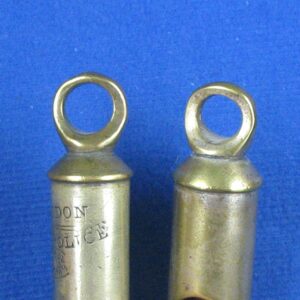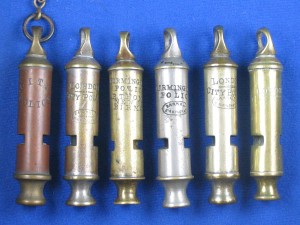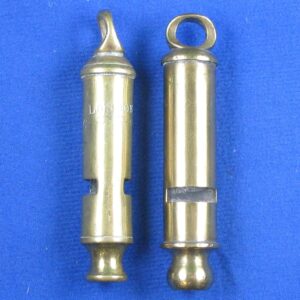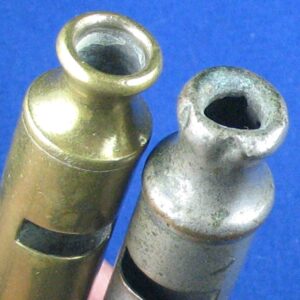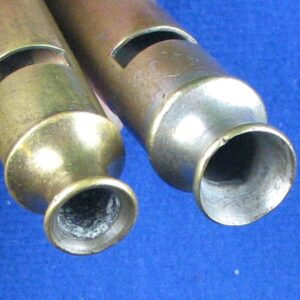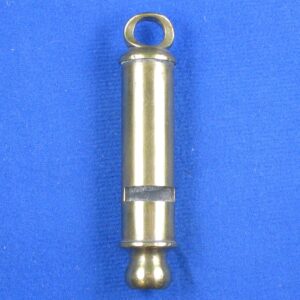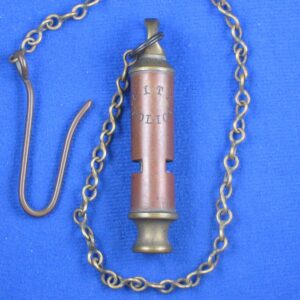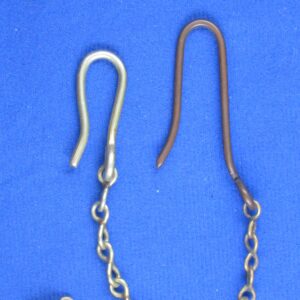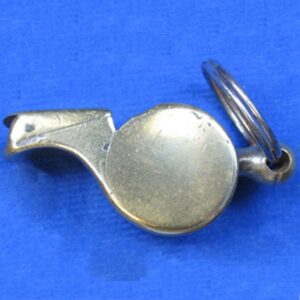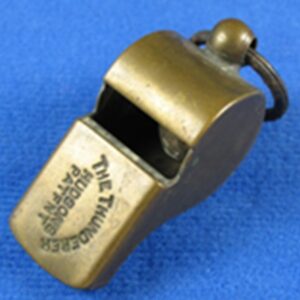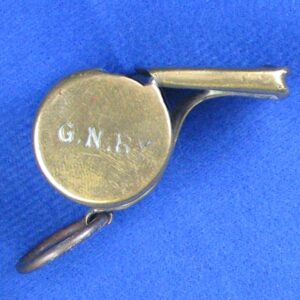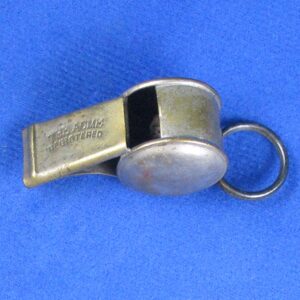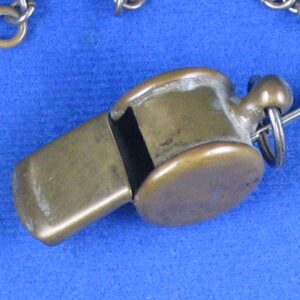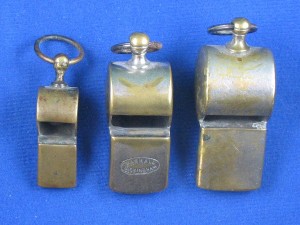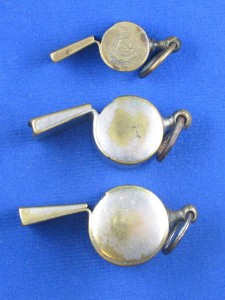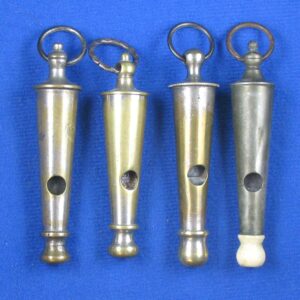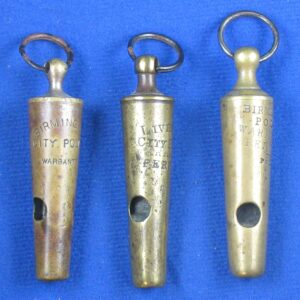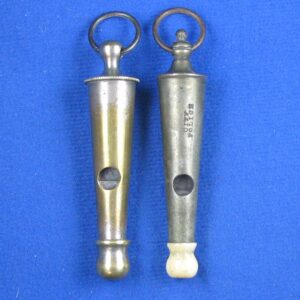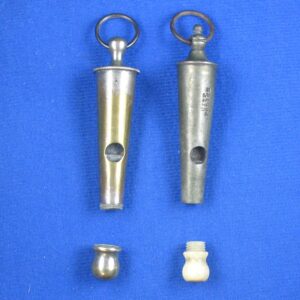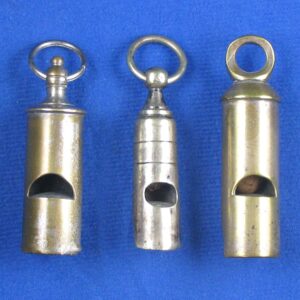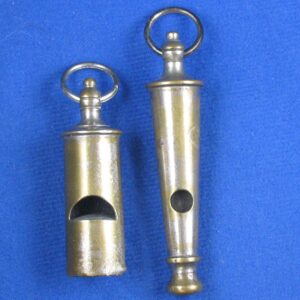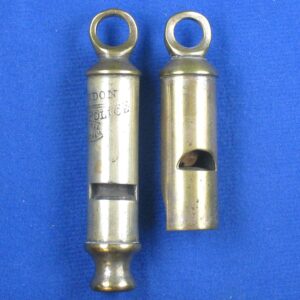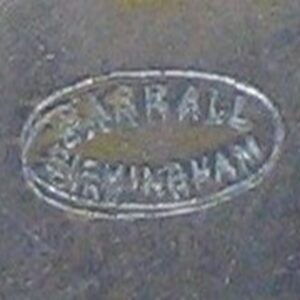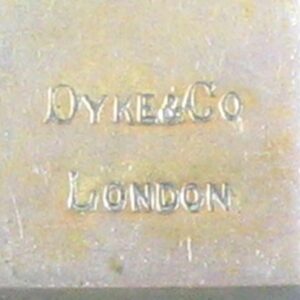Spotlight > Specific Manufacturer > United Kingdom > Barrall > 039
JOHN BARRALL — Birmingham
Manufactured whistles from 1886-1898 – 12 years
1A Caroline Street 1886-94
12 Parade 1895-96
115A Camden 1897-98
Although John Barrall made whistles for only 12 years, he had a significant impact on the whistle world that remains to this day. His use of distinctive sloped tops on tube shaped whistles was simple, yet managed to set his whistles apart in a time when whistle manufacturers were proliferating in Birmingham and other nearby cities, in the UK.
His beauforts were innovative in model sizes, top knops and caps, and was one of few manufacturers that combined ivory by using threaded connections – indeed perhaps the only one doing this with beauforts.
His creations with the emergence of escargot shaped whistles, set him apart as a high quality whistle designer and manufacturer with his elaborate knop designs. These hallmarks, along with an impressive array of at least six types of whistles and dozens of different models give rise to special attention.
What is unusual about John Barrall is that so little is known about his business and background. For the present his whistles will have to speak for him. His types of whistles known at present are as follows:
1) dual chamber heavy wall
2) tube shape – for the general public
3) tube shape — police issue
4) escargot
5) beaufort
6) round
First let’s examine dual chambered heavy walled whistles. In general these whistles spanned only a decade and a half of production in whistle history, from approximately 1885 to 1900. These are very heavy and well-made dual tube whistles. No example has been found of three or four chambered whistles of this style or from this time era. John Barrall’s business and his manufacture of his own dual tube heavy wall whistles, corresponded perfectly within these years.
Neither of his two whistles pictured here show tooth grips, as others incorporated in theirs – i.e. Ward, DeCourcy and Hudson. — Indeed only four manufacturers are known to have made these types of whistles and all are found in the UK.
Both models pictured are double knop tops and apparently unique to Barrall. He also had models which featured a single knop. Two types of window openings are seen here with square and half oval openings, the square windows being rare in these type whistles — if not distinctive.
A further original design is the opening of the mouthpiece. Cast and drilled out, compare his to an example of Alfred DeCourcy’s larger and single opening. Barrall’s drilled out openings directed the air directly into each chamber, whereas others had to split the air after entry into the mouthpiece itself, more like a pre-chamber or plenum.
None are known to have his stamp on them. The one or two top knops are cast, as well as the mouthpiece. In the USA dual tube whistles thin wall were made during this time era and prior. ( i.e. Banks and Brother, Overman, etc )
——————————————————————————————————————————————
Turning our attention to tube shaped whistles, we find that Barrall made whistles for general distribution to the public ( GSW general service whistles ) and police whistles contracted to different forces ( i.e. Birmingham, London and Liverpool, Dublin ) as well as a hybrid stamp City Police. A more elaborate and very rare Dublin Police issue ( un-pictured ) was sold on eBay that had a taller decorative pillar type knop usually seen on his escargots and beauforts.
Unique to his whistles are ‘domed’ top caps, which were very sloped. Although at first his whistles proved to be very rustic and less distinct in this regard yet they came to be very clearly set apart.
Rarely ones with tines on the disc are seen, which can be found in some pointing towards the mouthpiece opening. In this example Barrall utilized tines toward the mouthpiece. Usually one finds a cast disc and this is connected perpendicular to the partition wall inside the tube.
The rolled mouthpiece opening was introduced ( by Hudson ) in 1884-5 but Barrall made little use of it. His tube shaped whistles mostly used cast mouthpieces ( picture left ). He had two types of lathed out cast openings.
Some of his whistles ( picture right ) are found where they were ‘over machined’, one type ( left ) was typical and one type ( right ) was exaggerated in its opening — creating a much wider flare unique to his whistles.
Cast pieces were the usual parts ( i.e. top cap, disc, mouthpiece )
An unusual whistle is the following dating very early in his career. It can be found in brass and nickel silver ( Gilchrist ). The round cast type mouthpiece is typical of whistles in the very early 1880s but very rare to find one by John Barrall. It is larger than usual for him at 85mm.
It also has a unique feature of a single protrusion extending through the disc center attaching to the partition. No other examples are known to have done this.
Lastly is the only known example ( to date ) of a Barrall chain attachment. The hook is very large and almost exaggerated. It is attached with a split ring, which was very rare to see in chains of the day. The chain is braised link and found to be brass as another exception to nickel silver.
Perhaps the most istinctive of John Barrall whistles were his escargot designs. His use of unusual lengths, styles and sizes on his ornate knops was remarkably simple —– and yet overlooked by all other whistle manufacturers of escargots. ( Please see More Whistles by Martyn Gilchrist, page 12 )
As with the tops to his Beauforts, Barrall was very innovative, incorporating size, shape and milling. He also made use of sturdier material for such light construction whistles, although relying on 5 piece ‘London’ style designs. Indeed no Glasgow design escargots are known to have been manufactured by him although this type of design by Joseph Hudson had eclipsed all others others in production. — Note the rounded barrel sides to adding to their dimension and strength.
John Barrall’s escargots brought life to them. Rather than being a generic escargot shape, he gave variety and depth to an otherwise uneventful whistle.
He started his business in 1886 four years prior to McDonald’s and Auld’s 6 piece very heavy cast escargots and five years prior to the very successful and enduring design by Hudson, using the three piece escargot that would come to dominate the field. Note the next two examples of a heavy 6 piece and heavy three piece.
Hudson had developed some lighter escargots during the 1880s, breaking away from button whistles thereby creating new vistas for the escargot, but it was John Barrall that moved ahead with this vision, while Hudson moved toward main stream production. Here are three examples of Hudson’s ‘early’ whistles.
Barrall’s productions came in several sizes, from very small to large. All have been found to be brass or plated brass. None appear to be contracted to any police force. Here are three. One is very small and dates back to close to the inception of the Salvation Army. Only one is known at present.
The second bears Barrall’s logo inside the ellipse. The third and largest was marketed for Dyke and Co. Of London
It is of note that Barrall escargots are of such rarity that several of the ornate knops he used on escargots have not been found or affordred for display here. Please see More Whistles by Martin Gilchrest page 12 for examples.
As with escargots, John Barrell’s beaforts show remarkable design characteristics. What comes to the fore is the fact that when beauforts were waning in use and production ( even being taken on trade in ) with most whistle manufacturers, he was doing the opposite, breaking new ground and even excelling at it.
He manufactured different model sizes, designs and held on to markets that had seemed to have closed up. For example, Barrall still sold to the police forces of Birmingham, Liverpool. He expanded his line of top knops setting a higher standard than others were willing to reach for.
Even though Joseph Hudson had already flooded the market and taken London ( 1883-4 ) when John Barrall started his company ( 1886 ), his creativity and productions went against the tide that would ultimately consume him and all other whistle manufacturers of his day, by the Joseph Hudson company. It is also worthy of note that John Barrall’s knop designs remained distinctly his own when other companies could have copied or even tried to improve them.
Perhaps of all his whistles, the beauforts re-emergence became a sterling example of his creativity.
Features include:
1) elaborate top caps
2) extended top caps
3) milling around the cap edge
4) ivory mouthpiece
5) un-screwable mouthpiece for cleaning
6) cast mouthpiece
7) no mouthpiece
8) modified wedge design
It would appear that he was the only manufacturer to thread mouthpieces on to beauforts. Indeed few others used threads at all ( Stevens, Hawksley ).
——————————————————————————————————————————————
Lastly we look at round whistles by John Barrall. Three have now been identified. The first matches his beaufort and escargot designed top caps. The second is nickel silver, which is unusual for Barrall. It has a long neck top and oval window, yet another unusual sight.
The third pictured here is plated brass with a half round window. The ring top is rare for a round whistle by any manufacturer. It also is distinctive and an identifier as the one he used on his GSWs and police tube shaped whistles that are distinctive to John Barrall. This was very rare to use a ring GSW/Police top on a round whistle, as most round whistles have some sort of pillar top or round knop.
So far, here are three totally different round whistle designs, thus showing that Barrall was innovative and we should see more come to light. To see a few round whistles and that they would vary so greatly is promising to say the least.
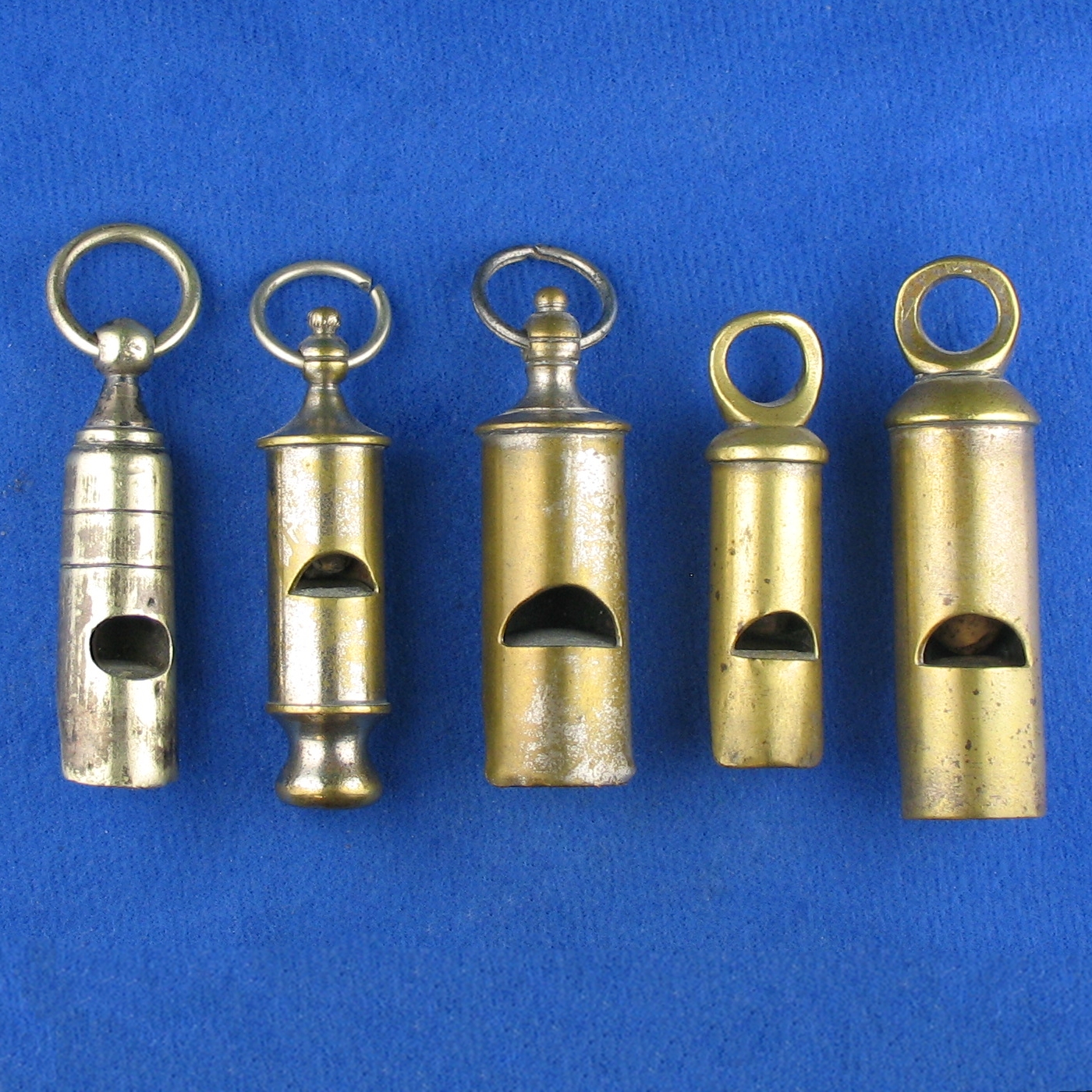
[ KNOWN BARRALL ROUNDS TO DATE JUNE 22, 2018 ]
What conclusions can we draw ?? That in only 12 years of manufacturing John Barrall proved creative, innovative and industrious. He pioneered areas of whistle design that have remained distinct to this day. Although his manufacturing was enough to be able to find and see many of his whistles today, there are also ones that are rare to very rare and some that are singularly known examples. Most likely there are ones that have not been identified.
Unique features
1) heavy walled dual tube – square windows, drilled openings in mouthpiece, double knops.
2) escargots – elaborate knops
3) tube shaped – sloped top caps, finial top caps, center protrusion through the disc.
4) rounds – sloped, finial top caps
5) chain – braised links of brass, extra large hook.
Even though little can be unearthed at present about his background, business and how he learned his trade, the whistles by John Barrall remain and reveal an accomplished and innovative whistle manufacturer.
Logo — Barrall Birmingham inside an oval ring
Stamp of distributor – Dyke & Co. London
Stamped commonly used – warranted perfect
On Round Pea: "J. Buck 124 New St", a distributor name
Bibliography:
Gilchrist, Martyn. More Whistles. Wincanton: M. Gilchrist, 2005. Print.
Gilchrist, Martyn, and Simon Topman. Collecting Police Whistles and Similar Types. Birmingham: Topcrest, 1998. Print.
– TWG
Posted December 20, 2014
